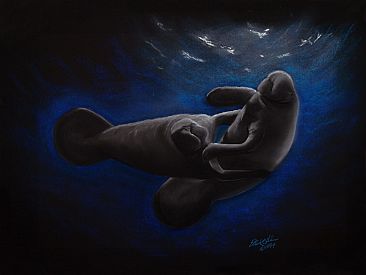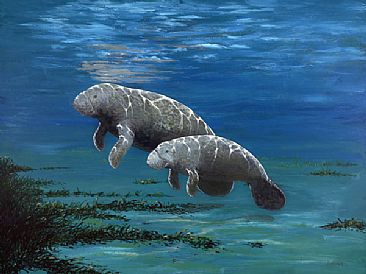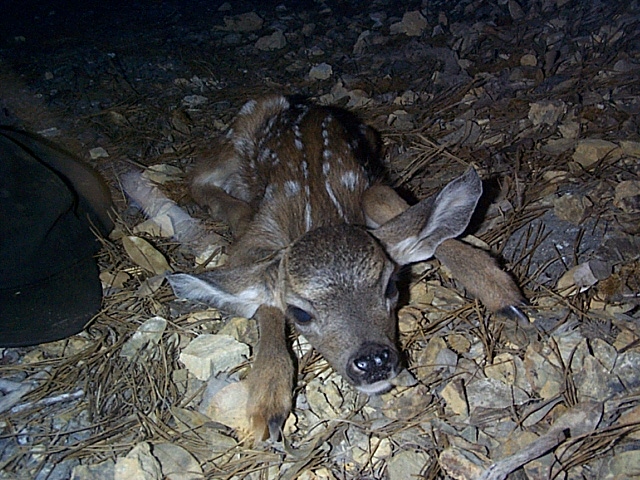A blog about animals including wildlife, horses, dogs, cats, and other domestic animals, as well as the artwork I create from them.
Nov 11, 2007
Encourage or Discourage Young Artists?
I myself, despite having a father who was very artistic, was strongly discouraged by both parents from even thinking about becoming an artist. It was so thoroughly knocked from my brain as a child that after years of struggling in college to decide on a major I never even considered art an option. Now I look back and so often wonder why.
I just don't understand why every non-artist (and many artists) are so quick to tell you that doing art for a living is "impossible" and a sure path to homelessness and despair.
Yes, I understand it is often a difficult road, but there are many paths in life that are difficult. Being a doctor, for example, is actually quite difficult. Medical school is extremely difficult, takes many, many years, costs a fortune, and leaves the graduate stressed and in an enormous amount of debt. Then, of course, s/he has to survive internship, also quite difficult. But do parents discourage their child from dreaming of being a doctor? No! What "good" parent wouldn't prefer their child pursue a career as a doctor instead of an artist? Very few, I'd imagine.
Why? I'm not sure. But I'd imagine it's because they believe all doctors are rich, and all artists are poor. Yeah, maybe, on average there are more doctors earning good salaries than artists. But I have known doctors who struggle financially, and there are many artists who are doing quite well.
But it's more than about money. For some reason in this country having your child grow up to be a doctor is something to brag about. Having your child grow up to be an artist is something to be ashamed of and deny.
I finally graduated from college with a degree in Business Administration. Six months after graduation I decided there was no way this was the life for me. I quit my job and started painting full time. One day my father asked me what he was supposed to tell people I do for a living now. I told him to tell them I'm an artist. He visibly cringed and replied that he couldn't possibly do that. He'd have to make up something up because it would be too embarrassing to tell people his daughter was an artist.
But it wasn't just my father. My mother also discouraged me, not because she was embarrassed by the idea of having a daughter as an artist but because she really believed, for some reason, that no one buys art. How could I possibly make a living when no one would ever buy one of my paintings?
And, of course, there were art teachers. It seems every art teacher in school believed that all artists were either starving or teaching, so unless I wanted to teach, I shouldn't bother to pursue art.
Yet, every issue of Wildlife Art magazine has stories of artists who have managed to "make it" to some degree in the art world. And this is just wildlife art. I'm sure there are many more landscape, still life, and portrait artists, among others, who are doing OK for themselves in the art world. So every time I read the story of some artist who made it despite discouragements I have to wonder how different things would have been had they listened. And then I wonder how many more artists there are out there who actually did listen to the discouragements and are now working in some dead-end job they hate, the world deprived of their works, they deprived of their dreams.
So if you are a teacher, counselor, parent, or just a concerned friend, and you know someone with dreams of becoming an artist, please do not discourage them. Let them try and find out for themselves one way or another. You may think you are saving them from disappointment but you may actually be destroying a dream that could have come true and now, because of you, never will.
Nov 5, 2007
Art Book Recommendation: Brushwork Essentials
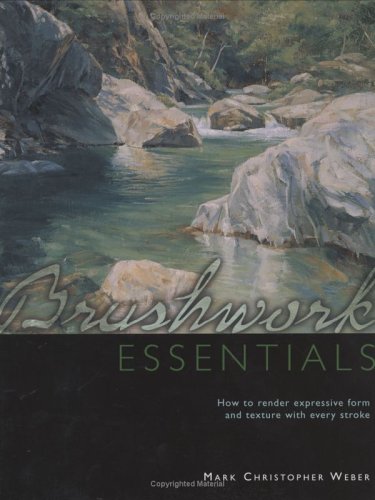
If you haven't already done so please visit his website to view samples of his extraordinary work.
Oct 29, 2007
Upcoming Art shows - Nov 2007
Nov 9-11
Waterfowl Festival
Easton, MD
www.waterfowlfestival.org
410-822-4567
Nov 9-21
Women Artists of the West 38th Annual Invitational
Hilligoss Galleries, Studio of Long Grove
360 Historical Lane
Long Grove, IL
www.hilligossgalleries.com
847-634-4244
Nov 10-11
Pepper Tree Art Show
3617 Roblar Ave
Santa Ynez, CA
www.peppertreeartshow.com
805-688-6205
Nov 16-18
Wildlife Art Festival the 25th Anniversary
2024 Orange Tree Lane
Redlands, CA 92374, USA
www.sbcounty.gov/museum/
909-307-2669
November 17-18
Eastern Pennsylvania Wildlife Art Show
Town Hall
New Hope, PA
Nov 17-18
Twelfth Annual Plantation Wildlife Arts Festival
Thomasville Cultural Center
US Highway 319
Jackson Street
Thomasville, GA
www.pwaf.org
229-226-0588
Shows to enter:
Nov 30 deadline
Endangered Species Juried Art Competition
Wildling Art Museum
www.wildlingmuseum.org
802-688-1082
Oct 22, 2007
Endangered Species in Art: Brown Pelican
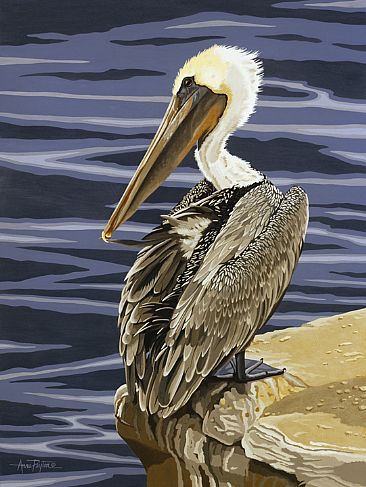
Turning to Preen
Subject: Brown Pelican
Dimensions (inches): 20 x 15
Medium: Acrylic
by
Anne Peyton
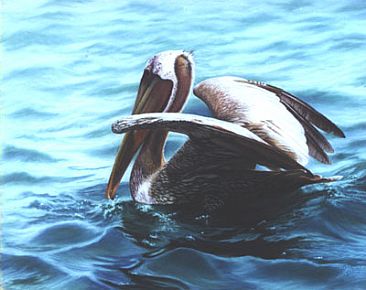
Soft Landing (2000)
Subject: Brown Pelican
Medium: Pastel on sanded paper
by
Judy M. Hohl

Brown Pelican
Subject: Brown Pelican
Dimensions (inches): (framed 10"x14")
by
Paul Makuchal
Oct 14, 2007
Uncommon Wildlife Art Subjects: Hyena
First of all, despite their reputation for being slobbering, filthy scavangers, some species of hyena are actually very efficient hunters. They are also highly intelligent, equal in intelligence to some ape species.
Another particularly unusual and interesting fact about the hyena is the presense of a psuedo-penis on the female hyenas. Read more about this and other interesting facts on Wikipedia.
So maybe you'll think about these animals in a new way as you enjoy some hyena paintings by some wonderful wildlife artists.
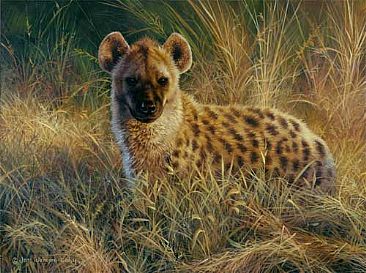
Subject: Spotted Hyena
Joni Johnson-Godsy
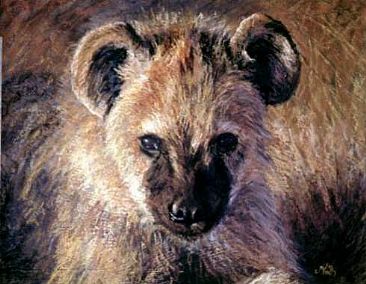
Angela Drysdale

Nico Bulder
Oct 6, 2007
Protecting Your Images Online
Artists new to the online art world are sometimes a little hesitant to put their images out there, fearing unauthorized use and distribution of their artwork. But there is so much opportunity for positive exposure on the internet that it would be a shame not to take advantage of it because of this concern.
There are several things you can do to help protect your images from unauthorized use. Watermarking is the probably one of the oldest and most common forms of protecting images. It won't stop people from downloading your image but it will make it unusable for printing or trying to take credit for the work. People are also less likely to want to download it when there's an obvious watermark on it. Here is an example of a typical watermark:

Not very pretty, though, is it?
There are other things you can do that won't ruin the appearance of your image. In order to download an image off a website people generally have to right-click on it to bring up the save image menu option. There is a javascript you can add to your site that will prevent people from right-clicking on your image and pop up a notice warning them that your images are copyright protected. This only discourages the less Web-savvy thieves out there, however, since it's really not hard to find the image URL by viewing the source and downloading it directly. They could also simply take a screen capture and crop and save the image that way.
Another option is to "shrink wrap" your image which is a way of putting a fake transparent image over the real image so when someone tries to download your image they think they're getting the real thing when, in fact, they are getting the transparent image. You can find out how to do this here on About.com.
Personally, I don't do any of these things, really. People distributing my art all over the web just means more exposure for me. The trick is to make sure my name and web address stay with my image so the free publicity does me some good so I add my name name and web address into my images directly. I guess you could call that a form of watermarking but it doesn't obscure the image the way the typical watermark does. Here's how mine looks:

You might argue that if someone wants to steal your artwork they could simply crop the name and address off the bottom. Well, yeah, they could. But I think the vast majority of people who download and distribute your images do so simply because they like it and want to share it with friends. I don't think they're trying to take the credit away from you and are unlikely to go to the trouble to crop the image. Names and links to the sources of images are usually just lost out of carelessness and lack of web page editing skills.
To discourage those who might actually want to steal credit for your work, or print it out, I suggest simply keeping your images low resolution and low dpi. Keep the dimensions smaller than 500 pixels and keep the dpi below 96. You can also add a 10-20% jpg compression which will further degrade the image. On your computer screen these adjustments won't affect the image much and it will still look decent on your web page. If your image is, say, 400 pixels wide at 72 dpi then when someone tries to print it out on their computer printer it will only be about 5 inches wide and won't look too great. Should they try to force it to fill the page in an attempt to get an 8"x10" print it will look downright horrid at that resolution and dpi. Maybe they'll be satisfied hanging that crappy postcard sized print on their wall but they certainly won't get away with trying to sell them as fine art prints to anyone but a blind person.
Sep 25, 2007
Endangered Species in Art: Leopards
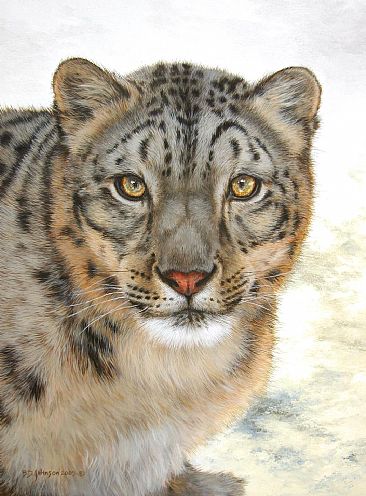
Brenda Johnson - 10% of sales of this print go to the Snow Leopard Trust
For more artwork devoted to endangered species conservation visit the endangered species art section of the Artists for Conservation web site.
Sep 19, 2007
Save a Deer, Shoot a Hunter! (Part 2)
Do you hate hunters and hunting? Does the idea of some slack-jawed neanderthal of a redneck/hick/hillbilly blowing the brains out of Bambi send you into a rage?
Hunting season is here and your jerk of a neighbor just loaded up his 4-wheeler with guns, bows, knives, and a 12-pack, heading off to the woods to end the lives of poor innocent creatures!
Can you believe that idiot?!
And, while steam is still coming out of your ears, do you sit down and think about the letter you're going to write to your congressman to ban hunting while you chow down on your plump juicy steak (or chicken or pork roast) dinner?
Damn hypocrite!
Yes, you!
What are you thinking, cursing hunters for shooting a deer while you eat the flesh of a cow? Are cows less worthy of life than a deer?!
Now, don't get me wrong. I'm not a vegan, or even a pescatarian. I don't believe humans were designed/evolved to live without eating animal protein. I actually tried vegetarianism for a while myself and my memory went down the tubes in hurry (which was really bad since I was in college at the time and my grades went to from a B+ average to more like a C). Yikes!
Besides myself, I personally have known several vegeterians, none of whom were healthy or even sane. That's not to say there aren't healthy and sane vegetarians out there. I just haven't personally known any so my experience with vegeterianism hasn't been a positive one.
Ok, so let me get back to the point.
I have met many people like you, who curse the idea of hunters and hunting while thinking it is perfectly fine to eat farm-raised beef, pork, and chicken. Heck, I was that way myself once. After all, that's what the cows and chickens are raised for, right? While ruthless hunters are just blowing the brains out of innocent animals for kicks, a gun in one hand and a beer in the other, laughing all the while, right?
Yeah, ok, if that's what you believe.
But actually hunters, at least the ones who eat what they kill, are doing less harm to animals and the environment than you are.
Wtf, you say!?
Yeah, really. Stop and think about it.
The most important non-CO2 greenhouse gas is methane, and the number one source of methane is animal agriculture or "factory-farming." According to EarthSave.org:
Methane is responsible for nearly as much global warming as all other non-CO2 greenhouse gases put together. Methane is 21 times more powerful a greenhouse gas than CO2. While atmospheric concentrations of CO2 have risen by about 31% since pre-industrial times, methane concentrations have more than doubled.
Animal agriculture produces more than 100 million tons of methane a year. And this source is on the rise: global meat consumption has increased fivefold in the past fifty years, and shows little sign of abating. About 85% of this methane is produced in the digestive processes of livestock, and while a single cow releases a relatively small amount of methane, the collective effect on the environment of the hundreds of millions of livestock animals worldwide is enormous.
So, you see, hunters who eat deer instead of factory-farmed cattle are doing more good for the environment than you are.
I know what you're thinking: "But, deers crap and fart too! Don't they release methane as well?"
Well, deer farts maybe. I don't really know. But not deer crap. Part of the problem with factory-farmed cattle is that there are millions of cattle all crammed together in pens (and if you've ever driven through central CA you'll know what I'm talking about) where waste accumulates in large quantities. In nature, deer crap is scattered sparsely throughout the woods. This gives it a chance to dry out rapidly and return to dust that nurishes the soil. In these factory-farm pens of cattle there is no room to scatter the waste sparsely, allowing it to dry. It accumulates knee-deep and rots, releasing huge amounts of methane in the process. Not only is this bad for the environment but the cows are probably miserable wallowing knee-deep in their own waste, too.
Which brings me to my second point. What about the lives of the animals you're eating? Which is worse off, the deer that roamed free and lived a natural life until the day a hunter's bullet took it down? Or the cow that was born wallowing in cow crap, living its entire short life crammed so tightly with other cattle it never had room to move or even lie down? This isn't just killing, as a hunter does to a deer. This is life-long torture. And the same goes for the way chickens and pigs are factory-farmed.
So next time you sit down to eat your meat-filled meal, think about the poor factory-farmed animals. If you can go vegan (and stay healthy and sane) then great! If not, I understand. But try to at least buy free-range meat, poultry, and eggs whenever you can.
And while you're eating your free-range chicken dinner, try not to hate your neighbor-hunter who's eating venison next door. That deer probably lived a happier, healthier, more natural life than your farmed chicken ever knew.
(For more information on factory farming and what you can do to help stop the cruelty visit FactoryFarming.com and FarmSanctuary.org)
Sep 13, 2007
Upcoming Shows and Exhibitions
Sept 8-Nov 11
Birds in Art Exhibit
Leigh Yawkey Woodson Art Museum
Wausau, WI
Sept 14-Oct 7
American Plains Artists 23rd Annual Exhibit
Loch Vale Fine Art
Estes Park, CO
Sept 15-16
North Georgia Wildlife Arts Festival and Outdoor Expo
Downtown City Park
Blue Ridge, GA
Sept 22-23
New England Wildlife Art Show
Earthplace Nature Discovery Center
Westport, CT
Sept 29-30
Maine Woodcarvers Association and Wildlife Artists Show
Augusta Armory
Augusta, ME
Oct 5-6
Bill Worrell and Barbara Westwood Annual Fall Show
Exposures International Gallery
Sedona, AZ
October 5-7
Wild Wings Fall Festival Original Art Show and Sale
City Hall
Lake City, MN
Oct 5-14
Georgia National Fair Wildfowl and Wood Carving Competiton Exhibit
GA National Fairgrounds
Perry, GA
Oct 12-14
17th Annual Reflections of Nature Wildlife Art Competition, Show and Sale
Saskatoon Prairieland Park
Saskatoon, Saskatchewan, Canada
Oct 19-21
Wildlife Art Show and Sale
Civic Center Plaza
San Dimas, CA
Oct 19-21
26th Annual Southern Wildlife Festival
John C. Calhoun College
Decatur, AL
Oct 20, 2007 – February 17, 2008
47th Annual Society of Animal Artists Exhibition
The Wildlife Experience
Parker, CO
Oct 27-28
15th Annual Woodcarving and Wildlife Art Show
East Berlin Area Community Center
East Berlin, PA
I'm sure there are many more shows and exhibitions going on out there so if you know of some not listed here add it to the Comments section here. Thanks!
Sep 8, 2007
David Kitler at Fort Worden Wildlife Art Expo
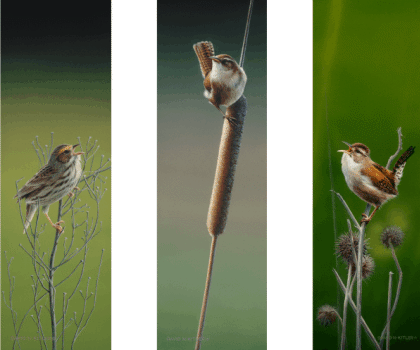
One of the expos he's attending this year is the Fort Worden Wildlife and Nature Art Expo in Port Townsdend, WA. I had the pleasure of meeting the artist at this same expo last year. He's very friendly, eager to meet people and answer any questions you may have. This year the event takes place Oct 5-7 so if you're in the area on those dates I' highly recommend you stop by and say hi to David. There will be lots of other great artists there too. For more info visit the Wildlife Art Expo site.
Sep 4, 2007
New Wildlife Expedition Journal Online!
Not mine, though.
Sorry.
The journal I'm referring to is that of wildlife artist Pollyanna Pickering about her trip to "The Land of the Thunder Dragon" to explore the nature reserves of Bhutan through the Flag Expeditions Program sponsored by Artists for Conservation.
I wish I had a new wildlife expedition journal of my own to talk about.
Well, in a way, no.
After reading her journal I have to admire her for what she went through on her journey. It sounds like it was pretty rough at times! But I'm glad she was willing to endure it to share her experience with us. Her journal contains over 200 pages of beautiful drawings and photos as well as fascinating notes about her trip! I highly recommend taking a look:
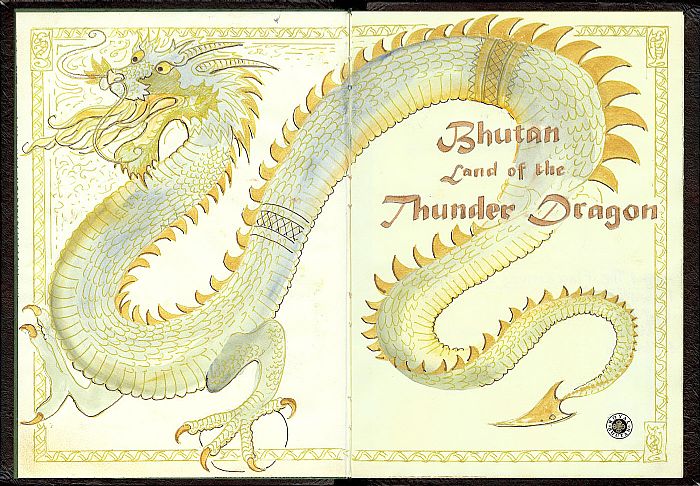
Aug 30, 2007
Uncommon Wildlife Art Subjects: Manatee
"Far from being slow learning, manatees, it turns out, are as adept at experimental tasks as dolphins, though they are slower-moving and, having no taste for fish, more difficult to motivate."
Well, you certainly won't find as much artwork on manatees as you would elk or tigers but there are some. So here some images I found of artwork of manatees, my first subject in my "Uncommon Wildlife Subjects" blog series. Enjoy.

I tried to find a painting of a dugong could only come up with a couple of illustrations, not what would be considered fine art. If you know of a painting of dugong let me know and I'll add it here. To help you identify them here's a chart of the various specious of the order Sirenia from Sirenian International. The most obvious difference is the tail, the dugong having one shaped more like a dolphin or whale while the manatee has a round paddle-like tail similar to a beaver. (Click the image for a larger view)

Aug 28, 2007
Cute and Funny Pictures of Deer

Source: AGPix, Erwin and Peggy Bauer
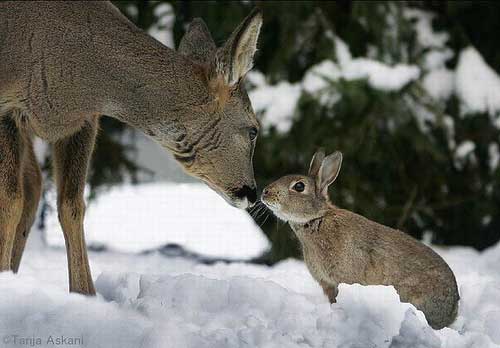
Source: Animal Intelligence

Source:http://www.flickr.com/photos/peaceofmind/368433676/

http://www.animalliberationfront.com/News/AnimalPhotos/Animals_21-30/HorseFawn.htm
 http://www.rawfoodinfo.com/articles/art_Bellathefawn.html
http://www.rawfoodinfo.com/articles/art_Bellathefawn.html

http://www.premierphotographer.com/funny_pics_1.html
Aug 26, 2007
Wildlife Art and Wildlife Conservation ... Why the Gap?
It seems only natural, right? And yet, I scratch my head and wonder why there is so little wildlife art offered by wildlife conservation organizations. Browse the online catalogs of organizations such was National Wildlife Federation or The Nature Conservancy and you will find all sorts of nature items, from books to bedspreads, but you will find surprisingly few wildlife art prints or posters and absolutely no original artwork.
I almost feel betrayed.
This lack of artwork is most puzzling to me since wildlife art and conservation seem a natural partnership. Wildlife artists have done so much for conservation efforts. Artists such as Robert Bateman have made huge contributions to conservation awareness and efforts. He was been honored with the Governor General's Award in Quebec City for his contribution to conservation in Canada, the Perkin’s Partner in Conservation Award presented by The Wild Canid Center, the U.S. National Audubon Society One of 20th Century’s 100 Champions of Conservation, and the Roland Michener Conservation Award presented by the Canadian Wildlife Federation, among others.
And yet, I have never once seen a print of his work offered in a conservation organization's catalog. Why?
Of course Robert Bateman is not the only wildlife artist who contributes to wildlife efforts. There's a whole group of wildlife artists dedicated to this effort, Artists for Conservation. As of this post member artists have pledged $13,943,109.79 to conservation funds. And yet, no conservation organization that I know of offers even a reciprocal link to this website.
Am I crazy, or is something wrong here?
Aug 21, 2007
Save a Deer, Shoot a Hunter!
But, seriously, we should protect wildlife by banning all hunting, right? Hunting is a cruel and unnecessary sport and hunters are just evil people who enjoy torturing animals and watching them suffer, right?
Well no, actually, I don't think so.
You're thinking, What!? You're a wildlife artist! You love wildlife! You love nature! You contribute to wildlife conservation! You care about animal rights! How could you possibly not support a hunting ban!? How could you not think hunters are horrible, cruel people!?
It's quite simple really.
First of all, the sad reality of this world is that it revolves around money. Wildlife conservation would not exist without money and hunters make huge contributions to wildlife conservation efforts through hunting licenses and through the support of organizations such as Ducks Unlimited and the Rocky Mountain Elk Foundation. Like it or not, without hunters there would be a whole lot less wildlife conservation going on.
Secondly, hunters aren't horrible, cruel people either. Well, not all of them anyway. I'm sure there are some bad apples out there just as there are in any group. But many hunters care very deeply about nature and wildlife. Now, I personally can't understand how you can love something and then kill it but I have met and talked with hunters enough to know there are such people. I don't know understand it but I know other people can feel that way somehow (just like I can't understand how anyone can like brussel sprouts but I know some people do!). I can tell by the looks in their eyes and the sounds of their voice when they talk about it that they love nature more than anything. These particular types of hunters are ethical and compassionate and have no desire to cause pain and suffering to the animals they hunt. Many are willing to let "The Big One" get away rather than hit it with a sloppy shot and they abhor sloppy, unethical hunters as much as we do.
I'm all for the ethical and humane treatment of animals but when attitudes become extreme then logic becomes flawed. While I appreciate the intentions of IDA, for example, something they said in an article about how to better reduce and control the deer population seemed a little absurd to me.
"Hunting does remove some animals from the population, but it does not keep deer populations at a continually reduced level. Immediately after a hunt, the remaining animals flourish because less competition for food exists, allowing the remaining animals to live healthier lives, and resulting in a higher reproductive rate."
"In Defense of Animals believes that sport hunting is not only an ineffective wildlife management tool, but a cruel and unnecessary practice. Sport hunting should be banned, allowing deer populations to regulate themselves naturally." (source)I have to wonder if they've given any thought as to how nature regulates deer populations "naturally." Some people feel that "natural" is always better. But if you think about it you'll realize that nature is often more cruel than humans. What IDA is saying above is that they want to see an end to the hunting that allows some animals to "live healthier lives" and instead let the populations increase until nature causes all the deer to suffer, since nature regulates populations through starvation and disease. This is an odd choice for an organization that supposedly cares about animals since starvation, malnutrition, and disease cause far more pain and suffering than a bullet. I don't know about you but if I had to choose I'd much rather take a bullet through the heart than die a slow agonizing death through starvation.
So try not to hate hunters, at least not the ones who are ethical and support wildlife conservation. They're doing more good for wildlife than they're doing harm to it. They're human like you after all and, whether you want to believe it or not, humans are part of nature too.
Aug 15, 2007
Do You Squidoo?
You can join through the group page here: Squidoo Wildlife Art Group
Ok, so ... for those of you who are scratching your heads going, "What's a Squidoo?" and, "Why would I want to be a member anyway?" .... well, I don't have a very clear answer really. I'm new to Squidoo myself and still trying to wrap my head around it. The closest thing I can describe it as is something akin to MySpace. It's basically just a place to show your stuff, share your interests, and network. The big difference between it and MySpace, however, is that it is more ... how shall I say it ... elegant? It's also more customizable and organized.
Another distinct advantage is, you can actually make money from having a Squidoo page (called a Lens). You can keep the money yourself of donate it to your favorite charity through their donation program. Here's what Squidoo has to say about making royalties from their site.
"It's simple. You make a lens. You recommend great stuff. Sometimes these you'll [sic] recommend a product from Amazon or eBay or CafePress or one of our hundreds of other commerce partners.
"Since Squidoo is free to use, we have to run a few ads on your lens in order to keep our doors open. So you'll see a few Google ads and SquidOffers on your lens.
"Now, since you're the brain behind the lens, you should get a cut! And better than a cut: you get HALF. That's right. Any time someone stops by your lens and buys a product you recommended or clicks on a Google ad, you get 50% of the royalties."
It's not just about showing off what you have to sell. If you have anything at all you like to talk about make a Lens on Squidoo. Do you have a passion for tropical fish? Make a Lens about that. Share your experiences with keeping fish. List your favorite books about fish, and your pet stores for buying fish, etc. Do you love sci-fi? Make a Lens about that and list your favorite books and movies. You might just make some $$ by doing it.
It's definitely worth checking out:

Aug 12, 2007
Artist's Book of the Month
We'll start this off with Problem Solving for Oil Painters: Recognizing What's Gone Wrong and How to Make It Right

Now, before all you watercolorists and colored pencil artists start yawning just hang on a second. One reason I want to talk about this book is because I thin the title is a little misleading. It really should be titled Problem Solving for Artists. There's very little in this book that doesn't apply to 2-D art of any medium. The artist/author, Gregg Kreutz, discusses things such shape, value, light, shadows, color, and depth, things important to consider whether you're using oil paints or pencils. He often shows comparison paintings of the same subject to clarify the differences he's talking about, which is very helpful.
Overall it's a great book for beginners and intermediates, although that doesn't mean some advanced artists won't find a few helpful points as well.
Aug 9, 2007
The 12-Step Program to MySpace Obscurity
1. Don't post any images of your art. Definitely don't put any pictures on your main page. Force visitors to click on your Pics link and when the do show them pictures of all your friends, family, and pets but not your artwork. That will bore them enough to leave your site very quickly. If you do decide to post some art images make sure they're private so no one can see them ... except, of course, your friends and family who have already seen them.
2. Avoid a consistent theme. Have pictures of a wide variety of your interests. Include pictures of Elvis, your dog's obedience class graduation, you and your friends at the last Star Trek Expo, or your favorite Playboy centerfolds (not that you'd ever see those last two together!). That will keep your page from looking at all professional.
3. Avoid anything related to your artistic interests. If you like to sculpt marine animals or paint seascapes be sure not to have any pictures that have anything whatsoever to do with the ocean or water. Show only images of your hamster's first birthday party instead.
4. Post your mug shot rather than art as your avatar. After all, someone interested in art who is browsing profile thumbnails might actually click on your thumbnail if they saw a picture of artwork. Make sure your thumbnail doesn't stand out among the millions. Additionally, make sure it's a poor quality image, the darker and blurrier the better. For extra obscurity make it a picture of you at your last bowling tournament with the whole bowling league in the background. With all that stuff in the picture no one will ever identify you or your artwork in that tiny 40x40 pixel thumbnail listing. Better yet, use the generic clip-art provided by MySpace.
5. Make your MySpace page difficult to read and navigate. Stylize your page to be so busy no one can find their way around. Make sure there are so many background colors that the text won't be visible on some part of the page no matter what color text you use. Or, you can go the other extreme and make your background all one color, then make your text match the background color. Green text on that lovely image of the rainforest works great. Or dark gray text against that stormy sky image is another wonderful way to get people to give up any hope of reading what you wrote.
6. Be sure to leave the About Me and Interests sections blank so no one will have a clue what your page is about. If you must put something there you can use obscure pictures, without descriptions, that leave it unclear as to why those images are there. Is that picture of palm tree on the beach a picture of your work? Or is it a work by an artist you admire? Perhaps it's a postcard from your last Hawaiian vacation? Or is it just a picture you found while surfing the web that you thought would add some nice decoration to your MySpace page? Keep viewers confused so they'll be sure not to relate your artwork to you.
7. Be sure to use poor grammar, punctuation, and spelling. You want to keep it unappealing and unprofessional. Be sure to include some fowl language, too. One particularly impressive site (for unappealingness) had in its About Me section, "The word 'f__k' is a regular part of my vocabulary..." (No, I didn't make that up) I'm sure that lack of professionalism will keep those big, bad, scary art galleries, dealers, and collectors far, far from her door.
8. Don't use any keywords on your page that might actually have you show up in a search. If you are a portrait artist be sure not to use either the word "portrait" or "artist" anywhere on your page. In fact, to be really safe, don't use any words at all. Search functions can't find you with just obscure images and and broken video links. And be sure not to use your name anywhere. You wouldn't want anyone to actually learn your name, or be able to search your name, or you might become a known artist.
9. Don't network. Don't add Friends, don't join Groups. Keep the existence of your MySpage page known only to you and your immediate friends and family who already know about your art. And, if someone should somehow accidentally stumble across your page they'll be sure to be turned off by the fact that you have exactly 1 Friend on your list, your mother. Additionally, require that people know your last name or email address in order to add you to their Friends list and be sure not to let either your name or address be known.
10. Music! Be sure to add loud annoying music to your page. Everyone loves your favorite song as much as you do, right? Of course not. So adding music, particularly if it's loud and irritating, is a sure way to get anyone clicking their browser's Back button in a hurry and get off them your page as quickly as possible. At the very least you'll get them reaching for the Mute button on their speakers and leave them in an unpleasant mood while they look over your page.
11. Don't blog regularly and don't write about anything interesting, especially anything related to art. You don't want people coming back for more! And you definitely don't want them thinking you have any interest in art despite your claiming to be an artist.
12. Decorate your page with ugly and obscene images. Having background images of gothic horror or artwork by Sorayama Hajime is sure keep your page from being family friendly. You'll eliminate a huge portion of the art market this way.
So there you have it. Do all, or at least most, of those things and you can be sure few people will get to know you and your art, or want to add you to their Friends list. At least you know I won't.
Aug 7, 2007
Dazzle Your Snail Mail with Zazzle
Anyway, I just got some postage stamps today....
You're thinking, yeah, so what?
Well, they're not just ordinary postage stamps. I got some postage stamps no one else in the entire world has. What's so special about my stamps, you ask? They have my artwork on them. :)
I got them printed up on Zazzle. Take a look!

Of course, there are lots of sites where I can have my wildlife art printed on coffee mugs, calendars, etc. But those things don't go anywhere where other people besides my immediate friends and family will see them.
These are real stamps I can use on real mail. Isn't that cool? :)
Of course it's not limited to artowork. Any image at all (well, within reason) can be uploaded nad turned into a postage stamp. Do you have an upcoming wedding? Send invitations with postage featuring the happy couple! When it comes time for mailing Christma cards send your cards this year featuring the happy face of your child opening gifts or sitting on Santa's lap.
Fore more info click on the Zazzle logo below.
Aug 4, 2007
Artists for Conservation
If you a wildlife art collector this is a great place to look for your next purchase. Artist membership to this group is limited and requires a review process. Only artists whose work is of high quality are accepted and allowed to display their work on this site so you can be sure you will be browsing some of the best wildlife art out there.
If you're an artist it's a great tool to help increase exposure, sell your art to a targeted market, and help contribute to wildlife conservation in the process. They advertise their website regularly in publications such as Wildlife Art Magazine. They keep a listing of upcoming events of interest to member artists as well as offering opportunities to participate in co-op advertising, member shows, and their Flag Expeditions.
Artists For Conservation is launching its fifth Flag Expedition this month with artist Alison Nicholls who will head off to Zimbabwe where she'll get to spend 6 weeks drawing and painting African Wild Dogs:
"In late August 2007, Nicholls will embark on a six-week expedition to Hwange National Park in northwestern Zimbabwe to locate Painted Dogs and create a detailed artistic field study of the dogs and their natural habitat. The name Painted Dog is derived from the Latin name for the species Lycaon pictus. African Wild Dog is the more commonly used name, but ...."For more info on the expedition visit their expedition page here.
Aug 1, 2007
Wolf Art, Art Wolfe, and the Art of Photographing Nature
Art Wolfe is truly an exception nature photographer not just because he is good technically but because his images are also very artistic. Artists can learn a lot from good photographers. After all, the basic rules of what makes good image regarding composition, lighting, and design are pretty much the same.
This TV series has some great film footage as well as snapshots of Art's images. In some areas the show also airs in HD (high-definition) so if you have a HDTV you're in for a real visual feast! (Check out the web site for information on when the show airs in your area.) Also, Art Wolfe himself is entertaining in the show. His passion, enthusiasm, and sense of humor make him amusing to watch. But besides that he's also informative. He talks about how and why he picks particular shots and what excites him about it, whether it's the lighting, color patterns, or the underlying abstract designs. If you have a DVR and can pause it be sure to do so when he talks these things. It helps to stop the DVR and analyze the shot he's referring to fully appreciate the artistic value. Imagining it as a painting, thinking about how you'd do a painting using similar ideas of light, color patterns, and design can be a great learning experience. This is definitely a must-see series for anyone interested in any combination of art, photography, and nature.
I'm also reading a book, The Art of Photographing Nature, by Art Wolfe and Martha Hill, former photography editor of Audubon magazine. It's a great book for both photographers and artists who want to photograph nature subjects to use in their art. Many examples in the book use multiple shots of the same subject to compare in order to discuss what makes one image better than the other. Both give their opinions on what makes the better image. Most of the time they agree, sometimes they don't. In either case it gives you a lot to think about and learn from.
Jul 31, 2007
Birds, Blooms, and Butterflies
Up here in the Pacific Northwest, at least in the area where I live, the most common visitors to the feeder (of sunflower seeds) are the black-capped chickadee and the house finch. The house finch has shown up in both the pink and orange variety. We also get the occasional chestnut-backed chickadee, robin, dark-eyed junco, and a towhee (I have yet to determine if it's the spotted or rufous-sided).
Chickadees are by far my favorites. They are just so darn adorable! I also love sitting outside in the morning sun with my dog and a cup of coffee, listening to them sing. What could be more relaxing?
The cute little chickadees are not always so pleasant though. They seem to be the fussiest and messiest of all the birds at the feeder. They toss out 10 seeds for every one they decide is acceptable enough to eat. LOL Oh well, that's all right. The finches and juncos don't seem to mind cleaning up the tossed seeds off the ground. And I also have a nice garden of sunflowers growing now too. :)
Since I've become more interested in birds I've recently discovered a very nice magazine for anyone interested in attracting birds and other fun critters to their gardens. It's called Birds & Booms and has some wonderful images of birds and butterflies as well as tips on how to select and grow flowers that attract them. Definitely worth checking out.
Oh yeah, I almost forgot to mention I also had a rare visitor to the feeder one day, a goldfinch! I'll end this with a the photo I managed to snap of him before he ended his very short visit. Isn't he cute!? I think I'll need to paint some birds soon.

Jul 30, 2007
Penguins, Polar Bears, and Global Warming

"This summer, from National Geographic Films and Paramount Classics—the team who brought you March of the Penguins and An Inconvenient Truth—comes Arctic Tale. Narrated by Queen Latifah, this inspiring documentary chronicles the epic journey of a walrus pup and a polar bear cub in the icy world at the top of the Earth. The film highlights the beauty of the far north and the urgent danger its animals face as their habitat continues to vanish.
"In conjunction with the release of Arctic Tale, Paramount Classics has created an Arctic Fund to support four organizations working to protect the Arctic and its inhabitants. The Wildlife Conservation Society is proud to be among those chosen to share in a portion of the movie’s box office sales.
"Arctic Tale opens in New York on July 25 and nationwide on August 17. For more information about the film, visit www.ArcticTaleMovie.com"
It's amazing to me how many people still believe that global warming is not an issue despite all the signs such as wild weather patterns, glacial meltings, and rising sea levels. I hope films like these will do more to raise awareness that global warming is a real issue we need to start adressing right now, before it's too late.
Find out more about global warming at the Union of Concerned Scientists website.
Jun 11, 2007
Why Limited Editions?
So who really likes art? Pretty much everyone. Art appeals to all human beings on some level. Have you ever entered a home that didn't have at least one picture on the wall? Unlikely. Sure, most of these people are not art connoisseurs or serious collectors. But should someone have to be in order to enjoy art? I'm not even sure collectors actually enjoy art. I had one buyer tell me that he collected so much art he had to keep much of it stored in boxes, including one of mine. He told me an original of mine he'd bought a while back was being safely kept packaged and stored under his bed. What?! Who's enjoying my art there? The dust mites?!
I've thought a lot about whether or not I want to get my art published as limited edition prints and I am pretty sure the answer is no. Yeah, I know, most artists would love to. Seeing their work as Limited Editions makes them feel like they've reached some level of success. There's some prestige about having your work in limited editions. And many people think that open editions and posters "cheapen" your art and reduce your ranking as a respected artist in the art world.
But that's what the "professional" art critics (and, sadly, many artists) think. But I don't paint for art critics. I want to share my art with everyday people, as many people as want to enjoy my art. The idea of Limited Edition (LE) is a bit snooty and egotistical, in my opinion. LEs are often beyond the affordability of everyday people. Especially when an artist becomes well-known their LE prints can cost more than their originals once did! LEs tell many people of ordinary means that they are not worthy of owning the art. Should I tell the dog groomer down the street that she is not worthy of owning my art because she is not a bank CEO? (And, considering anyone and everyone can get LE giclées made online these days I really don't think there's anything special about LEs anymore, anyway.)
One publisher I was with sold litterally tens of thousands of prints of one of my images. If that image had been a LE of only 1,000 how many people would not have that image now? Obviously more than 1,000 people wanted it. Why should I tell them they can't have it? No, I don't think LE prints are for me. I want to keep my images affordable and available for as long as people want to buy them. And what's wrong with that?
Jun 8, 2007
Website updated for print purchasing now
Jun 5, 2007
An Introduction, Part 5
But, of course, I had to earn a living and I had huge student loan debts to pay back. So what could I do? I had to keep going to work and trying to find a little time to paint on the side. Dreams of painting full-time just weren't realistic at that time. I needed to be practical, responsible, of course. Well, fortunately, that practical side of me only lasted about 6 months. I just couldn't take the boredom of accounting any more and quit my job with the "crazy" idea of painting full-time and somehow making it work. Hey, I'd survived as a starving student, why wouldn't I be able to survive as a starving artist? :)
It's hard to remember know how it started. Somehow a friend of mine told me about a guy who knew a guy who knew a guy .... who ran a local wildlife and western art gallery. I got an appointment to show my paintings and they were impressed enough to give me a shot. I needed to have, however, several more paintings before they'd give me a section of the gallery. Encouraged, I went home and painted like mad. After I had about 6-8 paintings I was in! My art was hanging in a real and reputable gallery!
(more in part 6)
Jun 4, 2007
I'm on an art buying binge!

But I didn't stop there. Just tonight I also bought a Jim Kasper print, and a clock with artwork by Lee Kromschroeder.
I'd better stop soon. I can't afford to frame all these! LOLJun 3, 2007
Leon Parson prints finally!
Barren Ground Monarchs
On the Move
I can't wait to get them framed and hung!
Who's one of your favorite wildlife artist?
May 28, 2007
An Introduction, Part 4
Well, before I graduated I'd already had a job lined up working in an accounts payable department for a well-known and very large healthcare firm. Couldn't be too bad, right? Math is, ummm, somewhat interesting. I kind of liked studying it in school. It should be all right ....
OMG, the accounts payable job was about as exciting as watching paint dry. No, actually, that's not true. If the paint were on a piece of art it would have been far more interesting to watch the paint dry! (For all you who work in accounts payable, I feel for you, and I'm sorry!)
Shortly after graduation and the new job my sister gave me a graduation card. In the card was a gift certificate to a local art supply store. It was kind of a surprise to me. I'd been so busy with classes, a part-time job, and studying that I hadn't even thought about art in a while. There'd simply been no time for it. Within the card was a note that said, "Maybe now you'll have time to express your true self."
After reading that I actually cried.
But it changed my life....
(continued in part 5)
May 24, 2007
Art on my Wall!
Next I'm determined to get a Leon Parson print. One of my favorites of his is, unfortunately, all sold out. I'll have to find a new favorite among the availables. Here's the one I wish I could have. I hope he doesn't mind me posting it here. I really wanted to share some of his beautiful work. I just love the way he uses color. He has every color of the rainbow in there yet it doesn't look gaudy or chaotic in the least. Somehow he keeps the colors harmonious and soothing. Amazing, in my opinion.

Check out his web site to see his other works: http://www.leonparson.com/
May 23, 2007
An Introduction, Part 3
So, last time I left off with that nasty word "reality." That meant thinking about what I was going to do for a long term career. It was time for college and I had to start thinking about what I was going to study. Strangely enough, art was not one of the majors I was considering. My father, as much as he liked art and nature, was always very negative about the prospects of earning a living doing art. The only artists are starving ones, you know. On top of the belief that all artists are starving my father also believed life was not about doing what you want to do, only about doing what you had to do. He even told me once that if I was having fun I was doing something wrong. Eek! (He grew up in New England during the depression years so I suppose it was the whole Puritan work ethic thing.) Consequently, I must have been convinced from an early age not to consider art as a possible college major because the thought of studying art actually never even occurred to me during my college years. Wierd, huh?
Unfortunately, when you remove someone's true love from the list of options there is nowhere to go. I ended up bouncing around from one major to another like a ball in a pachinko machine because I could find nothing that I truly wanted to make a career out of. This meant I also spent way too many years in college, but I won't bore you with all the details of those long years or the subjects I studied. I'll just jump ahead to graduation and the one thing that someone said that changed my life.... (continued in Part 4)
May 20, 2007
An Introduction, Part 2
As I got a little older and my father took me horse back riding more and more I started drawing horses more then deer. I fell in love with horses and when I was 13 years old my father finally caved from all my begging and pleading and bought me my first horse. That was it. That's all I cared about for the next decade, horses! I no doubt drew a gazillion pictures of horses during that time.
Eventually, however, I started to outgrow horses. I'm not sure why but somewhere in my 20's I turned back to nature and wildlife. I started spending more time out in nature again, hiking and camping and traveling the scenic routes of California and visiting national parks throughout the west. I took classes on wild edibles, native flora and fauna, and wilderness survival. Deer and other wildlife once again became a favorite art subject. I started to dream of doing art for a living. But then reality set in.... (More in Part 3)
May 19, 2007
I Need Art
Actually, I did manage to buy one print very recently, a picture of a family of lions by Dino Paravano. I've sort of been into monochromatic color schemes lately and I've always liked backlighting so this one caught my attention: Pride's Proud Family
Still, that's only one picture. I have many more walls to fill. Friends have told me to hang my own artwork on my walls. But I can't bring myself to do that. It seems too vain, conceited, egotistical, or something like that. What do you think?
May 18, 2007
An Introduction, Part 1
The first question I can answer ... maybe. LOL Well, at least I can tell you who I think I am, but whether or not I really know who I am has yet to be determined. :)
As for the second question, I can definitely say I have no idea. It's just a place to put down my thoughts, I suppose. I've tried keeping a regular journal in a physical book but, although I start it with enthusiasm, I never keep going with it for long. Maybe knowing someone might read this will motivate me to keep writing. Maybe not. Will you be the one who is disappointed? Or will I?
Ok, so back to the first question. This is who I think I am:
I am an artist. I am an animal lover. I am a nature lover. Specifically, I am a wildlife artist.
I was born in southern California, the daughter of a landscape painter and draftsman. My father loved to paint landscapes and do caligraphy. You know, I've never asked him why or where he got that from. Weird. In any case, I'm sure I picked up some of my artistic interest from him. As far back as I can remember I liked to draw, color, and paint. I drew so much that my parents couldn't keep enough paper in the house. I drew on practically any and every flat surface...well, that didn't get me grounded. My father, whose day job was that of a draftsman, often brought home huge stacks of used computer printer paper from his work for me to draw on the back of. This was in the days when computer printouts were on huge strips of perforated paper with holes along the sides for the printer feed, so the stacks could be quite large. (Yeah, you know I'm old now!) I had a voracious appetite for drawing and coloring and would make quick work of it. But it was the only way he could keep me from resorting to drawing on less desirable surfaces, like walls and tables.
My father was also a nature lover. One of his favorite shows to watch was Mutual of Omaha's Wild Kingdom, which I often watched with him. (Oh my! Now you really know how old I am!) He also enjoyed camping, fishing, hiking, and horse-back riding and often took me with him on such weekend outings.
As for the animal lover in me, well, that probably came from having so many pets. My father, despite being a nature lover, didn't actually like pets. My mother, however, loved them and wanted to rescue every abandoned animal in the world! At one point I think we had 13 cats, 5 dogs, a duck, a snake, and a turtle. And, I lived in a small suburban house, not a farm, so that was one crowded home!
This exposure to a combination to art, animals, and nature from an early age makes it seem only natural that wildlife art became one of my passions.
I had a little help from Walt Disney too.... (More on that in Part 2)



